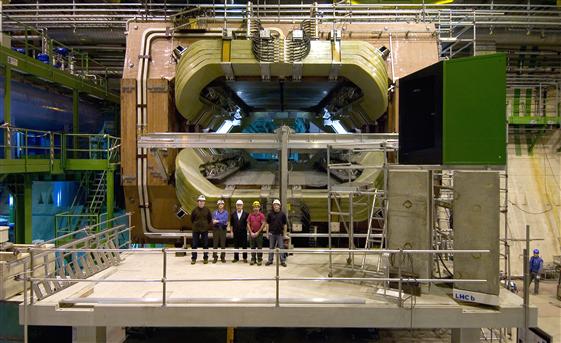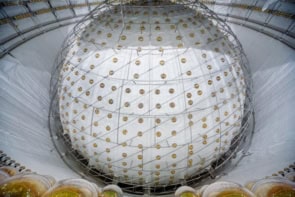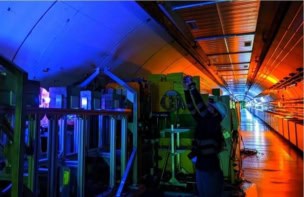
As particle physicists around the world gear up for the switch on of the Large Hadron Collider (LHC) at CERN later this year, UK researchers working on two of the collider’s four giant particle detectors are fighting to stave off funding cuts that would diminish their role in the multibillion euro project and may even jeopardize the operation of the detectors.
We should be on a high right now … Instead we’re facing an up-hill struggleNick Brook, Bristol University
“We should be on a high right now,” says Nick Brook of Bristol University, who has worked on the LHCb experiment for more than 10 years. “Instead we’re facing an up-hill struggle whereby we have to convince our paymasters that already agreed and peer-reviewed scientific goals are worth continued investment.”
In a review of its scientific programme released on 28 February, the Science and Technology Facilities Council (STFC), which funds all UK particle physics and astronomy, ranked the LHCb and ALICE experiments as “medium lower” and “lower” priority, respectively. LHCb is designed to study B mesons and help researchers understand the matter-antimatter asymmetry of the universe, while ALICE will recreate an extreme state of matter called a quark-gluon plasma thought to have existed immediately after the big bang.
£80m budget gap
As a result of the poor ranking, funding for the two experiments could be slashed to help plug an £80m hole in the STFC budget that emerged late last year. The council gave the community until 21 March to respond, and some 1400 letters and emails are now being assessed by 10 panels each devoted to a particular area of STFC science.
At a “town” meeting held on Tuesday at the Institute of Physics’ annual high-energy physics conference in Lancaster, UK, Val Gibson of Cambridge University, who is the country’s principal investigator of the LHCb experiment, called for the experiment be re-categorized as “high” priority.
“The STFC cannot claim that it supports world-leading science while grading LHCb as medium-lower priority,” Gibson told a packed auditorium. Her statement, which was one of many that were critical of the way the STFC has handled the funding situation, comes on top of several strongly-worded letters signed by over 400 people in support of the experiment.
Particle physicists accept that cuts to projects are inevitable, but many question the way in which projects were ranked. Combined with the council’s sudden decision in December for the UK to pull out of the International Linear Collider (the potential next big thing in particle physics after the LHC), some researchers have lost faith in the STFC management and fear the UK’s international standing in particle physics is being damaged.
Finite funds
Along with the ILC, the STFC pulled funding for ground-based solar physics experiments straight away and also withdrew UK membership of the Gemini observatory. The latter decision has since been reversed, in part thanks to strong opposition from the community. (Indeed, the situation for ILC is also better than it looked three months ago, with “non-zero” funds having been allocated to fund a minimal programme in generic linear-collider research.) Astronomers are now trying to ensure the future of the Jodrell Bank observatory as a result of the eMerlin radio-telescope project having been ranked in the same “lower priority” category as ALICE.
The LHC is the most powerful particle accelerator ever built, and will ram protons into one another at unprecedented energies for at least a decade. Its two largest detectors—ATLAS and CMS, employing over 4000 members of which about 200 are at UK institutes—were ranked “high priority” by the STFC-appointed particle physics, astronomy and nuclear physics science committee (PPAN). This is mainly due to their potential to discover new phenomena, such as the Higgs boson or supersymmetry, and means their funding is 100% secure.
Because LHC projects have become the major component of our programme, we have had to look more subtly at differences between them and consider investment priorities John Womersley, STFC Director of Science Programmes
Numerical scoring system
“Because LHC projects have become the major component of our programme, we have had to look more subtly at differences between them and consider investment priorities,” STFC Director of Science Programmes John Womersley told physicsworld.com. Although STFC has refused to release details of the numerical scoring system used by PPAN to rank projects, the physics that LHCb would produce “was not expected to have as high an impact as that the LHC general purpose detectors”.
However, while few dispute the ranking of ATLAS and CMS, many particle physicists do not understand why LHCb (which has about 100 UK members) and ALICE (a dozen or so) do not even make it into the second highest “medium high” category. As stated in a letter to STFC from the LHCb management, which is not UK based, this appears to conflict with STFC’s own statement that “full exploitation of the LHC” is one of its most important future activities.
STFC has failed to understand the discovery potential of LHCb Val Gibson, Cambridge University
“STFC has failed to understand the discovery potential of LHCb”, said Gibson, pointing out that the experiment may even be the first to find new particles via the subtle quantum effects they would have on the properties of B mesons. At a practical level, she says, a 10% cut in funding could reduce the resources for data analysis (e.g. post-docs and graduate students) by 25%. Furthermore, since the UK built and is operationally responsible for two of LHCb’s inner detectors, a loss of UK expertise could degrade the performance of the experiment.
Cutting funding for ALICE could have similar consequences. This is because, while small, the UK group is responsible for the “trigger” that will check the LHC collisions to see whether they are worth reading out. “It would be crazy to pull out at this stage because it would mean the experiment wouldn’t run for the first year,” says group leader David Evans of Birmingham University. “It’s like buying a brand new car and leaving it in a field to rust because you can’t afford to put petrol in it.”
Moving forward
Jenny Thomas of University College London, who is a member of STFC’s Science Board, points out that while the community has expressed plenty of anger about the programmatic review, it has been short on solutions to the funding problem. “Were funding for ATLAS or CMS to be shaved off [as some researchers have suggested], there is no reason why those funds should go to LHCb rather than to an astronomy or astrophysics project,” she told the Lancaster meeting, adding that negative stories in the press are not helping anyone.
Womersley agrees. “What was needed to be said has been said and noted, and there is not much to be gained by repeating it endlessly,” he told physicsworld.com. “While we can’t increase the amount of money available, we can address things like communication and make sure we do a better job of listening.” Many in the community have been frustrated with the lack of transparency in the council’s decision making, invoking the UK’s Freedom Of Information act to obtain minutes of meetings.
Several senior figures — including European director of the ILC project Brian Foster and Dave Wark of Imperial College (whose neutrino experiment, T2K, was ranked lower than he would have liked) — also appealed for the community to accept the funding situation and move on to embrace the LHC era. How easy that will be now depends on the outcome of the consultation process. Each of the 10 panels is due to report back in May, and PPAN will then digest the reports and present a revised recommendation to the Science Board. The STFC executive will then consider the final proposal and aims to make budget announcements in early July.
“We will try to do our best,” said particle-physics panel chair Steve Lloyd of Queen Mary University, who faces the onerous task of distilling 100 or so responses — half of which concern LHCb. “But don’t expect miracles.”




